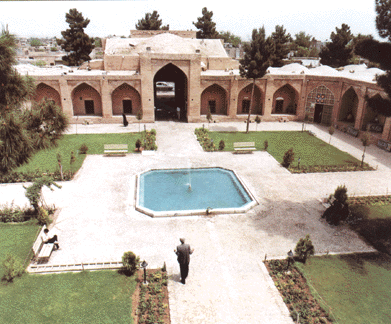Formerly located out of Neyshaboor Gate, it is now situated in the city center near Khayyam Square. Dating back to the safavid period, it is four-aivan construction and enjoys 24 chambers around the interior courtyard. It was used as a poor house in the Qajar period and as a garrison in the Pahlavi period.
After the Islamic Revolution of Iran it was under the authority of
Jahad-e Sazandegi Organization. In 1988 Cultural Heritage Organization began to restore the structure. In 1955, contemporary to the holding of the celebration congress of ‘Attar Nayshaburi, it was inaugurated as a cultural complex and a museum.
The construction was restored in order to have a presentation centre for the traditional handicrafts and support the native craftsmen. Displaying superb pre-Islamic and contemporary objects of Neyshaboor, the museum is located on the eastern boundary of the structure. The carvansary includes a theatre and a traditional tea-house and chambers displaying traditional arts and handicrafts such as mat braiding, give weaving, carpet weaving, turquoise carving, illumination, miniature, mosaic work, lattice work, mosaic faience, tile working, pottery, traditional clothing, gifts of Neyshaboor, traditional photographer`s studio, making traditional instruments and riddle making.
In order to support the Iranian culture and art, the Cultural Heritage Organization organises educational classes such as pottery, tile making, ceramic making, traditional artistic works.
Its National Monuments Registration Number is 3.1230.
Some other carvansaries are located on the Silk-Road, near Neyshaboor was well. The most important of them are Shooryab Carvansary, situated 50 km southwest of Neyshaboor, in Shooryab village. Dating back to the Qajar period, it is one of the most handsome and resplendent carvansaries. Other carvansaries are Chahsalar, south of the city, Qadamgah and Qal´eh Vazir, on the road to Mashhad. Each of them enjoys special importance.
|

